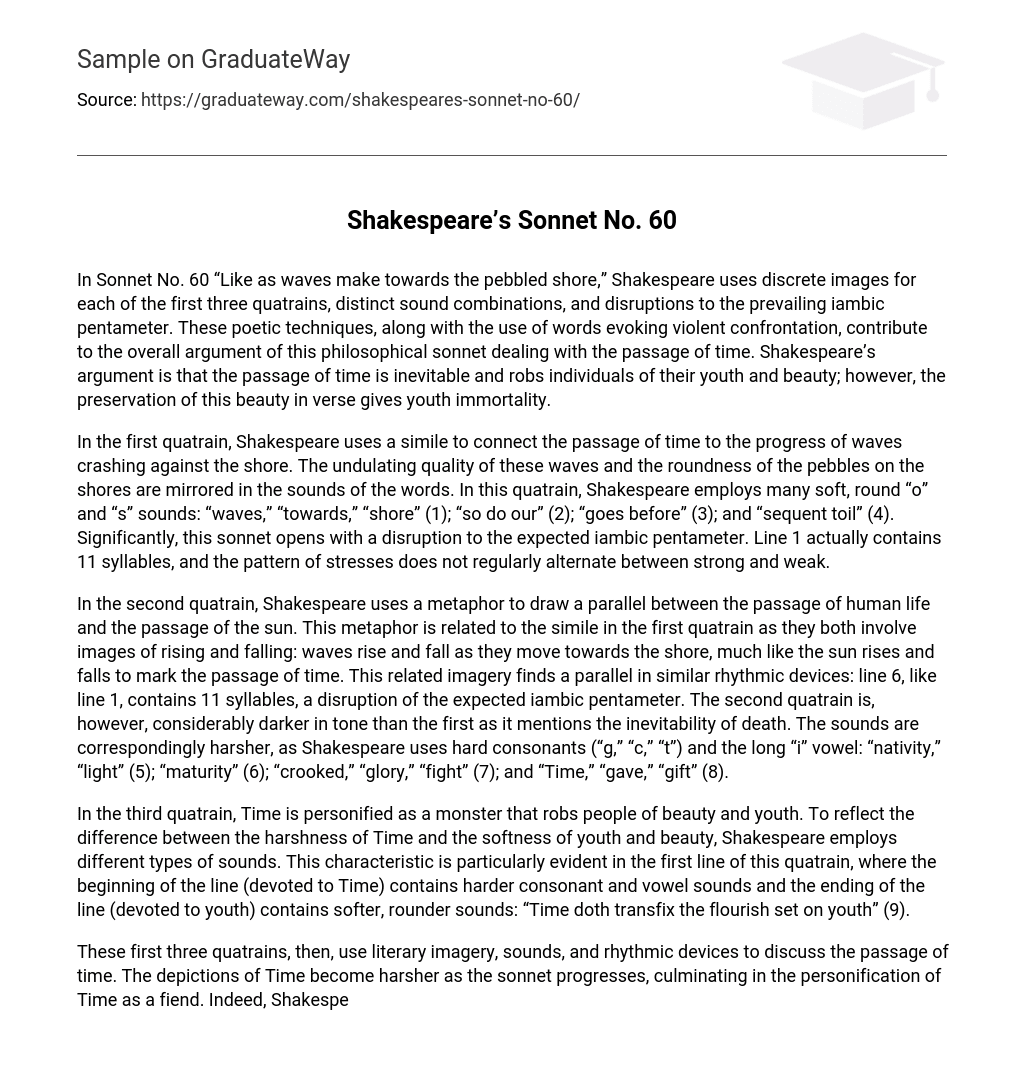In Sonnet No. 60 “Like as waves make towards the pebbled shore,” Shakespeare uses discrete images for each of the first three quatrains, distinct sound combinations, and disruptions to the prevailing iambic pentameter. These poetic techniques, along with the use of words evoking violent confrontation, contribute to the overall argument of this philosophical sonnet dealing with the passage of time. Shakespeare’s argument is that the passage of time is inevitable and robs individuals of their youth and beauty; however, the preservation of this beauty in verse gives youth immortality.
In the first quatrain, Shakespeare uses a simile to connect the passage of time to the progress of waves crashing against the shore. The undulating quality of these waves and the roundness of the pebbles on the shores are mirrored in the sounds of the words. In this quatrain, Shakespeare employs many soft, round “o” and “s” sounds: “waves,” “towards,” “shore” (1); “so do our” (2); “goes before” (3); and “sequent toil” (4). Significantly, this sonnet opens with a disruption to the expected iambic pentameter. Line 1 actually contains 11 syllables, and the pattern of stresses does not regularly alternate between strong and weak.
In the second quatrain, Shakespeare uses a metaphor to draw a parallel between the passage of human life and the passage of the sun. This metaphor is related to the simile in the first quatrain as they both involve images of rising and falling: waves rise and fall as they move towards the shore, much like the sun rises and falls to mark the passage of time. This related imagery finds a parallel in similar rhythmic devices: line 6, like line 1, contains 11 syllables, a disruption of the expected iambic pentameter. The second quatrain is, however, considerably darker in tone than the first as it mentions the inevitability of death. The sounds are correspondingly harsher, as Shakespeare uses hard consonants (“g,” “c,” “t”) and the long “i” vowel: “nativity,” “light” (5); “maturity” (6); “crooked,” “glory,” “fight” (7); and “Time,” “gave,” “gift” (8).
In the third quatrain, Time is personified as a monster that robs people of beauty and youth. To reflect the difference between the harshness of Time and the softness of youth and beauty, Shakespeare employs different types of sounds. This characteristic is particularly evident in the first line of this quatrain, where the beginning of the line (devoted to Time) contains harder consonant and vowel sounds and the ending of the line (devoted to youth) contains softer, rounder sounds: “Time doth transfix the flourish set on youth” (9).
These first three quatrains, then, use literary imagery, sounds, and rhythmic devices to discuss the passage of time. The depictions of Time become harsher as the sonnet progresses, culminating in the personification of Time as a fiend. Indeed, Shakespeare uses numerous words to evoke violent confrontations, with the frequency of these words gradually increasing throughout these three quatrains: “toil,” “contend” (4); “crown’d” (6); “glory,” “fight” (7); “transfix” (line 9); “delves” (10); “feeds on” (11); and “scythe,” “mow” (12).
Though these three quatrains culminate with reference to the inevitability to Time’s destruction, the couplet demonstrates that the poet has found a way to sidestep the deleterious effects of time. The volta is announced by the signal phrase “And yet” at the beginning of line 13. References to the subject’s beauty are tied into images earlier in the poem through a rhythmic disruption in line 14: this line contains only 9 syllables. By preserving the subject’s beauty in verse, this beauty can escape the ravages of time and gain immortality. This volta, then, ends the sonnet on a positive, optimistic note.





